Lasswell Harold D. The Political Writings of Harold D. Lasswell
Подождите немного. Документ загружается.

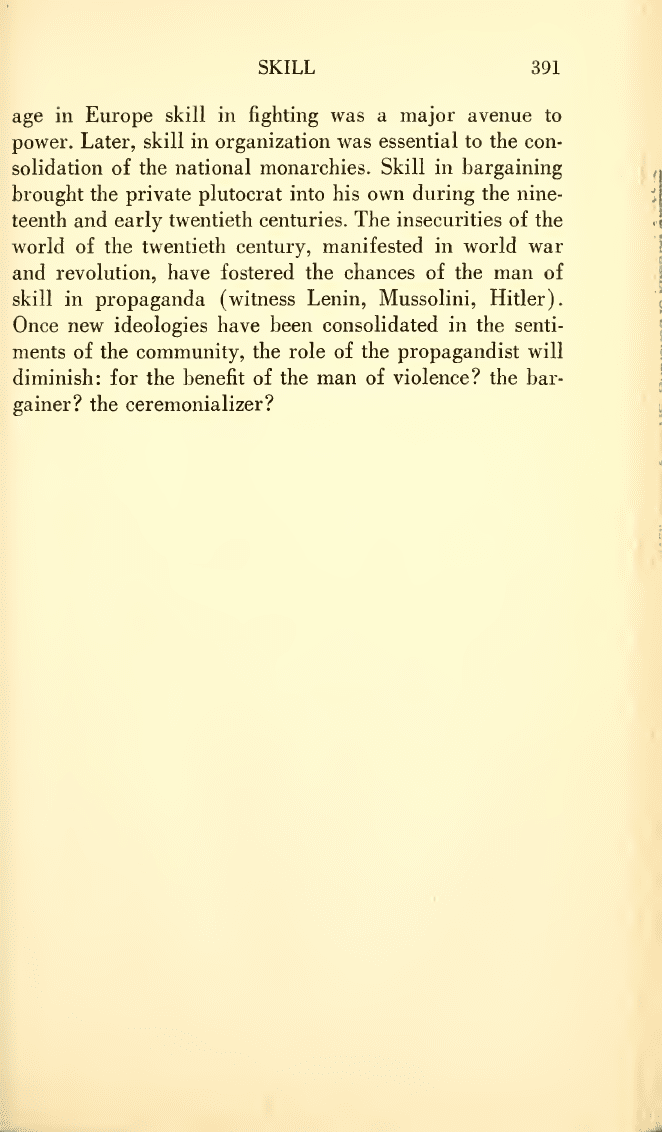
SKILL
391
age in
Europe
skill in fighting was a
major
avenue
to
power. Later,
skill
in
organization was essential to the con-
solidation of the
national monarchies.
Skill in bargaining
brought the private
plutocrat into his
own during the
nine-
teenth and
early twentieth
centuries. The insecurities
of the
world of the
twentieth century,
manifested in world war
and revolution,
have fostered the chances of
the man
of
skill
in
propaganda (witness
Lenin, Mussolini, Hitler).
Once
new ideologies have
been consolidated in the senti-
ments of the community, the
role of the propagandist will
diminish: for
the
benefit of the
man of violence? the
bar-
gainer?
the
ceremonializer?

CHAPTER VII
CLASS
Political analysis includes
the class consequences
of
events. A class
is a
major social
group of similar function,
status, and outlook.
A revolution is a shift in the class composition
of elites.
The influence
of the Southern landed aristocracy on Amer-
ican
politics
was curtailed as a result of the Civil War.
On
the world
stage
there
was
no significant
novelty about sub-
stituting commercial and industrial capitalists
for landed
proprietors. This
change had occurred under
circumstances
of
catastrophic violence in
France
at the end of the
eight-
eenth
century. In
world
perspective, the American
Civil
War
did not, but the
French
Revolution did,
signify
that
a
new
social
formation
had
risen
to greatest influence. The
French Revolution, therefore, may
be
called
a
world
revo-
lution.
After the revolution in France the next world
revo-
lution took place in Russia in 1917.
World
revolutions have been accompanied by
sudden
shifts
in the ruling
vocabulary
of the elite.
Said
the abso-
lutist
James
I of Great
Britain,
in
the
days
before
the gen-
try revolution:
"It is
atheism and blasphemy to dispute what
God
can
do ... so
it is presumption and high contempt
in
a subject
to
dispute what
a
king can
do,
or to say that a king
cannot
do
this
or that."
In the same strain are the words of Bishop
Bossuet, com-
missioned
by
Louis XIV with the
education
of
the Dauphin,
before
the bourgeois
revolution:
"As in
God
are united all perfection and
every virtue,
392
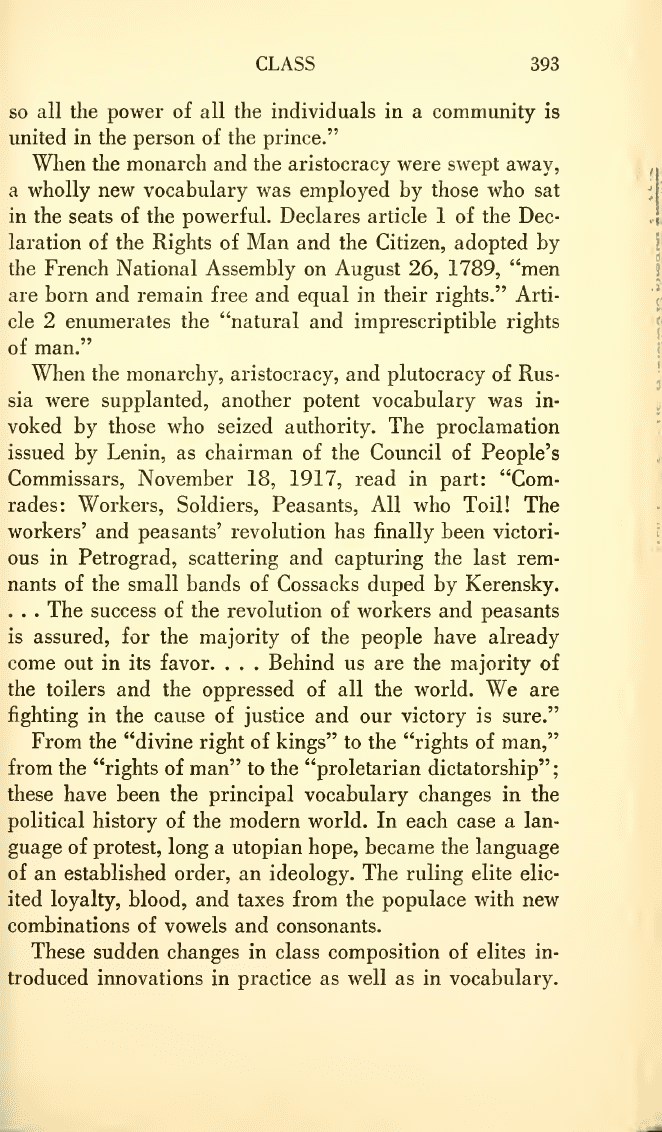
CLASS
393
so
all the power of all the individuals in
a
community
is
united in the person of the prince."
Wlien the monarch and the aristocracy were swept
away,
a
wholly new vocabulary was employed by those who sat
in
the seats of the
powerful.
Declares
article
1 of the Dec-
laration
of the
Rights
of Man and the
Citizen,
adopted by
the French National Assembly
on
August
26,
1789,
"men
are born and remain
free
and
equal
in their
rights."
Arti-
cle 2 enumerates the "natural and imprescriptible rights
of man."
When the monarchy, aristocracy, and plutocracy
of Rus-
sia were supplanted, another potent vocabulary
was in-
voked by those who seized
authority.
The proclamation
issued by Lenin, as chairman of the Council
of People's
Commissars, November
18,
1917,
read in part:
"Com-
rades: Workers,
Soldiers, Peasants, All who Toil!
The
workers' and peasants' revolution has finally been victori-
ous in Petrograd, scattering and capturing the
last rem-
nants of the small bands of Cossacks duped
by
Kerensky.
. .
. The
success of the revolution of workers and
peasants
is
assured, for the majority of the people have already
come out in its favor.
. .
. Behind us are the majority
of
the toilers
and the oppressed of all the world.
We
are
fighting
in the cause of justice and
our
victory is
sure."
From
the "divine right of
kings"
to
the
"rights
of
man,"
from the "rights
of man" to the "proletarian dictatorship"
;
these
have been the principal vocabulary changes in the
political history
of the modern world. In each case a lan-
guage
of
protest,
long a Utopian hope, became the language
of an established order,
an ideology. The
ruling elite elic-
ited
loyalty,
blood,
and taxes from the populace with
new
combinations
of
vowels and consonants.
These
sudden changes in class
composition
of elites in-
troduced innovations
in
practice
as well as in vocabulary.
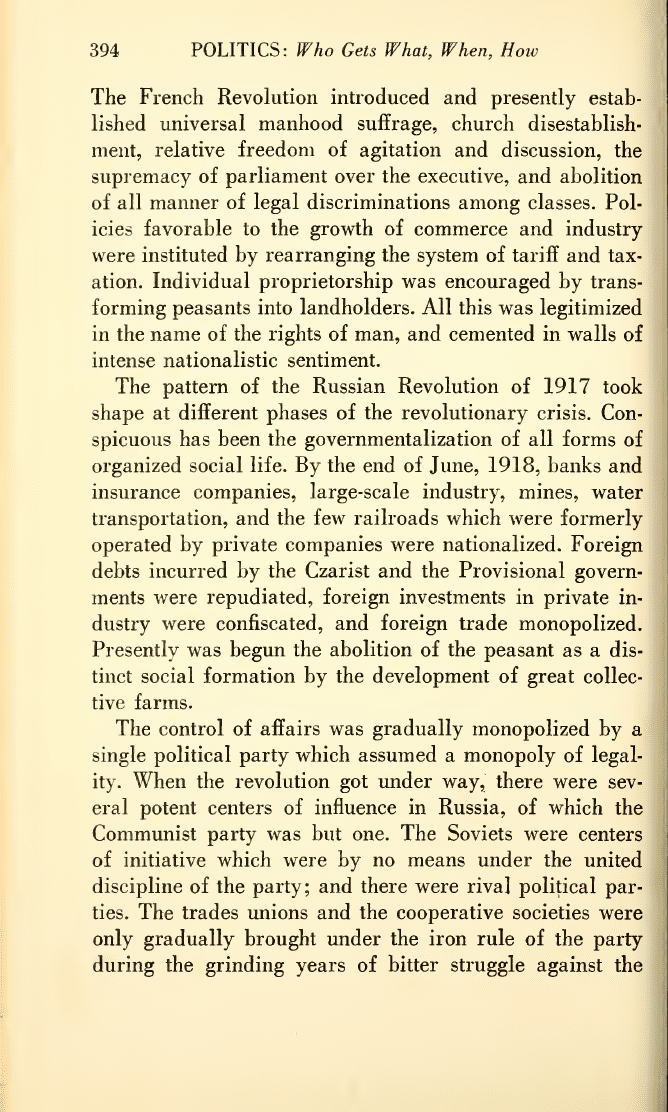
394
POLITICS: Who Gets What, When,
How
The
French Revolution introduced
and presently
estab-
lished
universal manhood
suffrage,
church
disestablish-
ment,
relative
freedom
of agitation and
discussion,
the
supremacy of
parliament
over
the executive,
and abolition
of all
manner of legal discriminations among classes.
Pol-
icies favorable to the growth of commerce and
industry
were instituted by
rearranging
the system of tariff
and tax-
ation.
Individual
proprietorship
was encouraged
by trans-
forming peasants into landholders. All this
was legitimized
in
the
name of the rights of man, and cemented
in walls
of
intense nationalistic sentiment.
The pattern of
the Russian Revolution
of 1917 took
shape at
different phases of the revolutionary
crisis.
Con-
spicuous has
been the governmentalization
of all forms
of
organized social
life. By the end of
June, 1918,
banks
and
insurance
companies, large-scale industry,
mines, water
transportation,
and the few railroads which were
formerly
operated by
private companies were nationalized.
Foreign
debts
incurred by the
Czarist
and the Provisional
govern
ments
were
repudiated, foreign
investments in private
in
dustry
were confiscated, and
foreign
trade
monopolized
Presently was begun the
abolition
of the peasant
as
a dis
tinct social
formation by the development of great
collec
tive farms.
The control
of
affairs was gradually monopolized
by
a
single political party which assumed
a
monopoly
of legal-
ity.
When the revolution got under way, there
were sev-
eral potent centers of
influence
in Russia, of which
the
Communist party was but one. The Soviets were
centers
of initiative which were by
no means under
the united
discipline of the
party;
and
there were
rival political
par-
ties.
The
trades unions and the cooperative
societies were
only
gradually brought under the iron rule of the
party
during the grinding years of
bitter
struggle against
the

CLASS
395
perils of
intervention, famine, and revolt.
Crisis forced
concentration
or collapse, and the
political
committee of
the
Communist party became the directive
center
of the
state.
Within the
framework
of the
governmentalized society,
differences in money
income were
less
striking than they
had
been in the
prerevolutionary
society;
this comparative
equality was
particularly
conspicuous
during the period
of
incessant conflict before
1921. The road to individual
suc-
cess now
lay chiefly through the Communist party, which
gave
access
to
the principal posts of
influence.
This
was a
"dictatorship of the
proletariat,"
or at least
a
dictatorship in the
name
of
the proletariat. It was not a
socialist state, because democratic
forms were not yet per-
mitted. It was not
a
socialist society,
because
the govern-
ment was still constrained to use coercion; "the
withering
away of
the
state" was
an aspiration for the future, when-
ever a
voluntary consensus among functional groups in the
new society
should emerge.
World revolutions are
valuable landmarks in the under-
standing of intervening events. Thus some
events after the
French Revolution can be considered to
facilitate, and
some to retard, the spread of the various details of the
new
revolutionary pattern of symbol and
practice.
Some events
were moving directly toward the emergence of the
pattern
which arose in Russia. Thus happenings can be construed
as transitions between one revolutionary emergent and the
next one.
After the French Revolution many details of the French
pattern of "democracy" were adopted and adapted. Great
Britain
widened the parliamentary
franchise
in the direc-
tion
of universal suffrage. Parliaments
came
to
exercise
greater
control over executives, even
where revolution did
not eliminate
monarchial
authority
(as
in Prussia). There
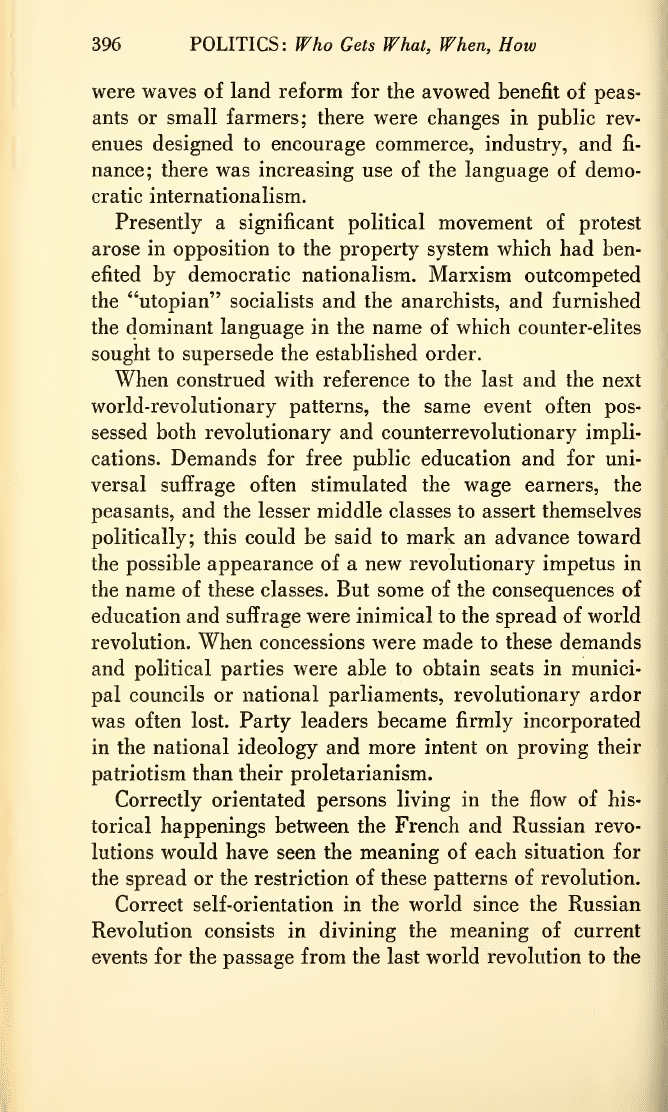
396 POLITICS: Who Gets What, When,
How
were waves of land reform for
the avowed benefit
of peas-
ants
or
small farmers; there
were changes
in public rev-
enues designed to encourage
commerce, industry, and
fi-
nance; there was
increasing
use of
the language
of demo-
cratic internationalism.
Presently
a
significant political
movement
of
protest
arose in opposition to the property
system which
had
ben-
efited by
democratic nationalism. Marxism
outcompeted
the "utopian" socialists and the anarchists, and furnished
the
dominant
language in the name of which counter-elites
sought to supersede the established order.
When construed with reference to
the
last and the next
world-revolutionary patterns,
the same
event often
pos-
sessed
both revolutionary and counterrevolutionary impli-
cations. Demands for free public education and for uni-
versal suffrage often stimulated the wage earners, the
peasants, and the
lesser
middle classes to assert themselves
politically; this could be
said
to mark an advance toward
the possible appearance of a new
revolutionary
impetus in
the name of these classes. But some of the consequences of
education
and suffrage were inimical
to
the spread of world
revolution.
When concessions
were
made to these demands
and
political parties were able to obtain seats in
munici-
pal
councils
or
national parliaments, revolutionary ardor
was
often lost. Party leaders became
firmly
incorporated
in the
national ideology and more intent
on proving their
patriotism than their proletarianism.
Correctly orientated
persons living in the flow of his-
torical
happenings
between the
French and Russian revo-
lutions
would have seen the
meaning of each situation
for
the spread or the restriction of these
patterns
of
revolution.
Correct self-orientation in the
world since the Russian
Revolution
consists
in
divining the meaning of current
events
for
the
passage
from the last
world revolution
to the
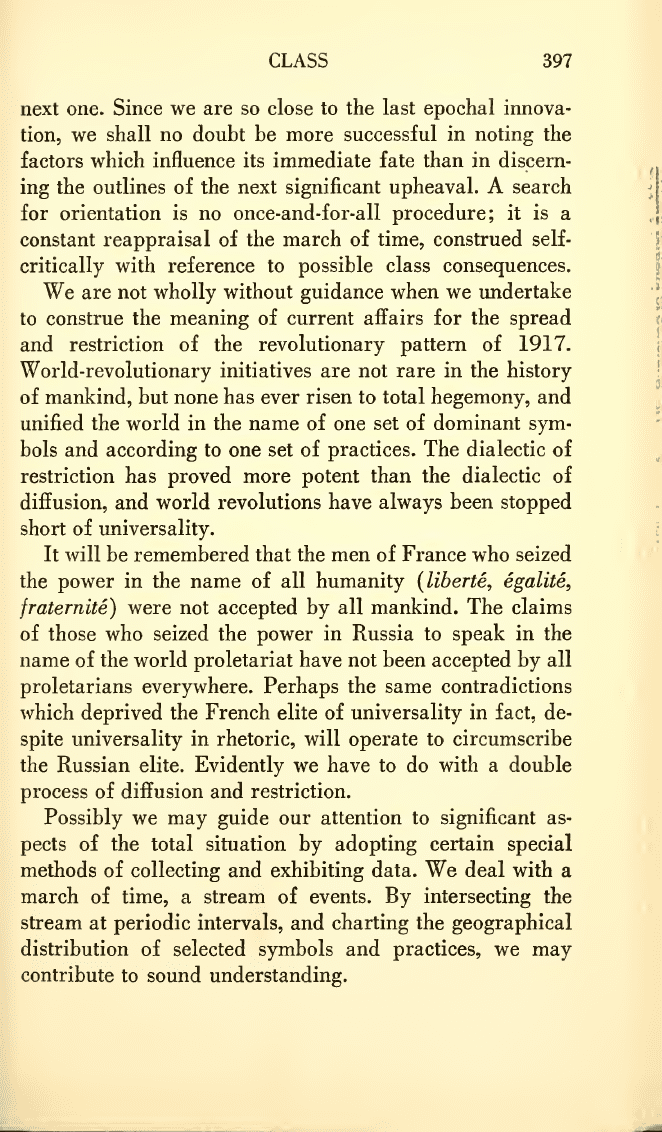
CLASS 397
next
one. Since
we are
so close
to the last epochal innova-
tion,
we shall
no
doubt be
more successful in
noting
the
factors
which influence its immediate fate than
in discern-
ing the
outlines of the next
significant upheaval. A search
for orientation is no
once-and-for-all procedure;
it
is
a
constant
reappraisal
of the
march
of
time, construed self-
critically with reference to
possible class consequences.
We are not wholly
without guidance when we
undertake
to construe the
meaning of current affairs for the spread
and
restriction of the revolutionary pattern of
1917.
World-revolutionary initiatives are not rare in the history
of
mankind, but
none
has ever risen to total hegemony, and
unified the world in the name of one set of
dominant
sym-
bols and
according
to
one
set
of practices. The
dialectic
of
restriction has proved
more potent than the
dialectic
of
diffusion,
and world
revolutions have always
been
stopped
short of
universality.
It will
be
remembered that the men of France who
seized
the
power in the name of all humanity {liberie,
egalite,
fraternite)
were
not
accepted by all mankind. The claims
of those who
seized the power in Russia to speak in the
name
of
the world proletariat have not been accepted by all
proletarians everywhere. Perhaps the same contradictions
which
deprived the French elite of universality in fact, de-
spite universality in rhetoric, will operate to
circumscribe
the Russian elite. Evidently we have to
do
with
a double
process of diffusion and restriction.
Possibly we may guide our attention to
significant
as-
pects of the total situation
by
adopting
certain
special
methods of collecting and exhibiting data. We deal with
a
march of time,
a
stream of events.
By intersecting
the
stream
at periodic intervals, and
charting the geographical
distribution
of selected
symbols and practices,
we
may
contribute
to sound
understanding.
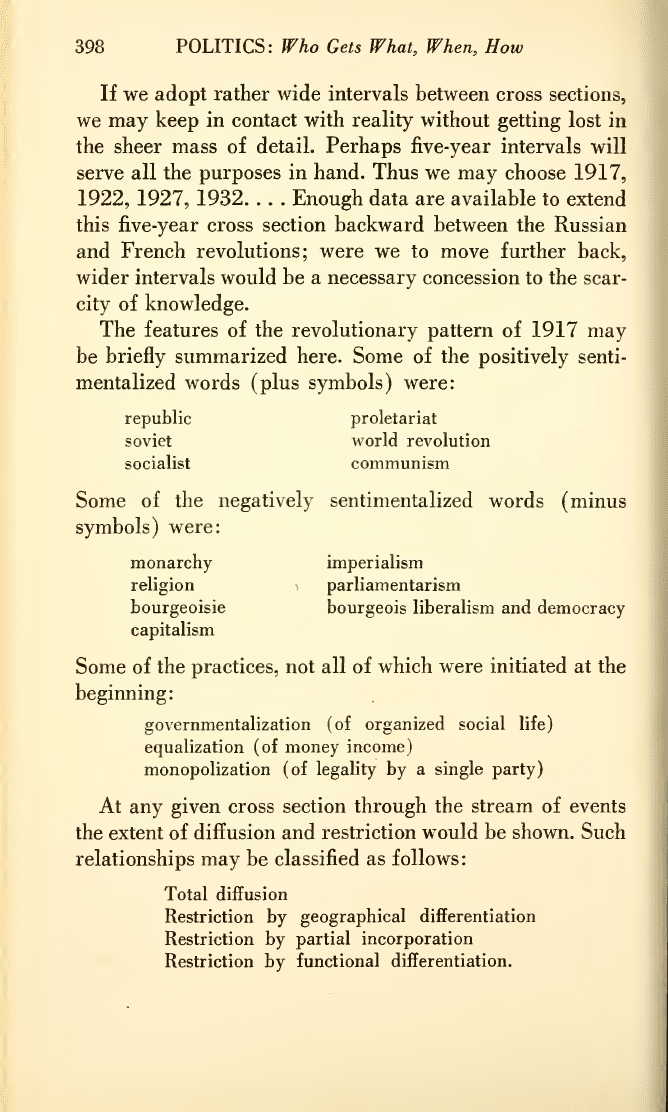
398
POLITICS:
Who Gets What, When, How
If
we
adopt
rather wide intervals
between cross sections,
we may
keep
in
contact with reality without
getting lost in
the sheer
mass of detail.
Perhaps
five-year intervals
will
serve all the purposes in hand. Thus
we
may
choose
1917,
1922,
1927,
1932 Enough data are available
to extend
this five-year
cross section backward between
the Russian
and French
revolutions; were we to
move further back,
wider intervals would
be a
necessary concession
to the scar-
city of
knowledge.
The features of the revolutionary pattern
of 1917 may
be
briefly summarized here. Some of the
positively senti-
mentalized words (plus symbols) were:
repubhc
proletariat
soviet
world
revolution
socialist
communism
Some
of the
negatively
sentimentalized
words
(minus
symbols)
were:
monarchy imperialism
religion parliamentarism
bourgeoisie
bourgeois liberalism
and democracy
capitalism
Some
of the
practices, not all of
which were initiated
at the
beginning:
governmentalization
(of organized social life)
equalization (of money
income)
monopolization
(of legality by a
single party)
At any given
cross section through the
stream
of events
the extent of
diffusion and
restriction would
be
shown.
Such
relationships
may
be
classified as follows:
Total
diffusion
Restriction by
geographical
differentiation
Restriction by
partial
incorporation
Restriction
by
functional
differentiation.
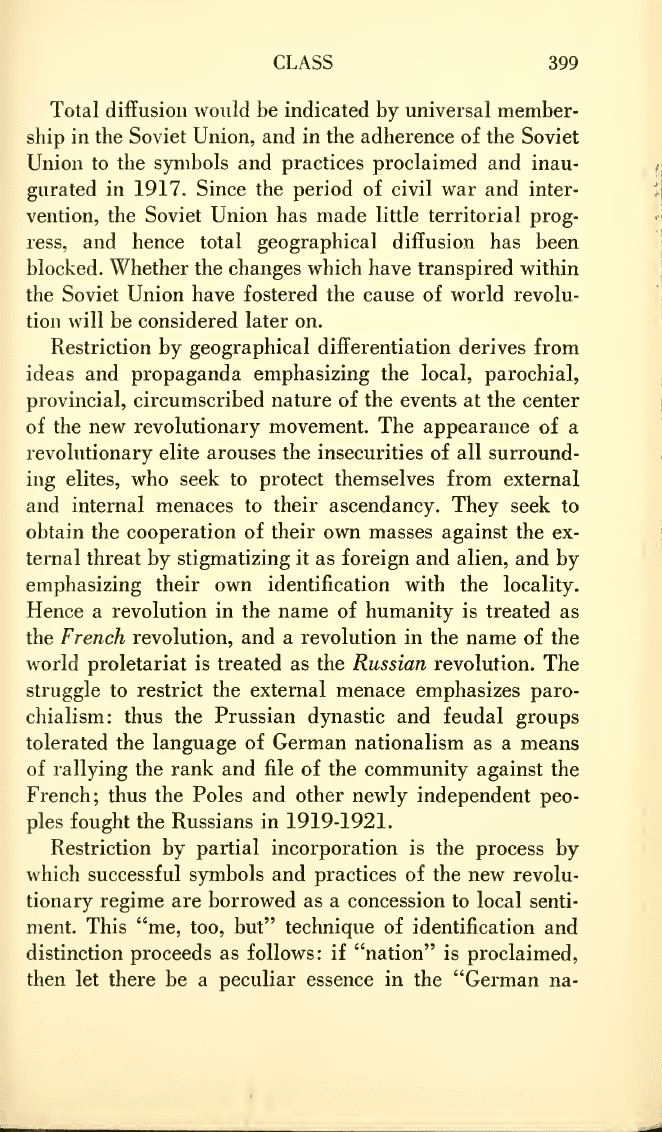
CLASS
399
Total diffusion
would
be indicated by universal
member-
ship
in the Soviet Union, and in the adherence of the
Soviet
Union to the
symbols and practices proclaimed and
inau-
gurated in
1917. Since the period of civil war and
inter-
vention, the
Soviet Union has made little territorial
prog-
ress, and
hence total geographical diffusion
has been
blocked.
Whether the
changes which
have
transpired
within
the Soviet Union have
fostered
the cause of world revolu-
tion
will
be considered later on.
Restriction
by
geographical differentiation derives
from
ideas and
propaganda emphasizing the local,
parochial,
provincial, circumscribed nature
of
the events
at the
center
of the new
revolutionary movement.
The appearance
of
a
revolutionary
elite arouses
the insecurities of all surround-
ing elites, who seek to protect themselves from external
and internal menaces to their ascendancy. They
seek
to
obtain
the
cooperation of their own masses
against the ex-
ternal
threat by
stigmatizing it
as foreign and alien,
and by
emphasizing their own
identification
with the
locality.
Hence
a
revolution in the name of humanity is
treated
as
the
French revolution, and a revolution in the
name of the
world proletariat is treated as the Russian revolution.
The
struggle
to
restrict the external menace
emphasizes paro-
chialism: thus the
Prussian dynastic
and feudal groups
tolerated the language of
German
nationalism
as a means
of
rallying
the
rank and file
of the community against
the
French; thus the
Poles and other
newly independent
peo-
ples fought the Russians in
1919-1921.
Restriction
by
partial incorporation is
the process
by
which successful
symbols
and practices of the new
revolu-
tionary regime
are borrowed
as a concession to local
senti-
ment.
This
"me, too, but" technique of identification
and
distinction
proceeds as follows: if "nation" is
proclaimed,
then let
there be a peculiar essence
in
the "German
na-
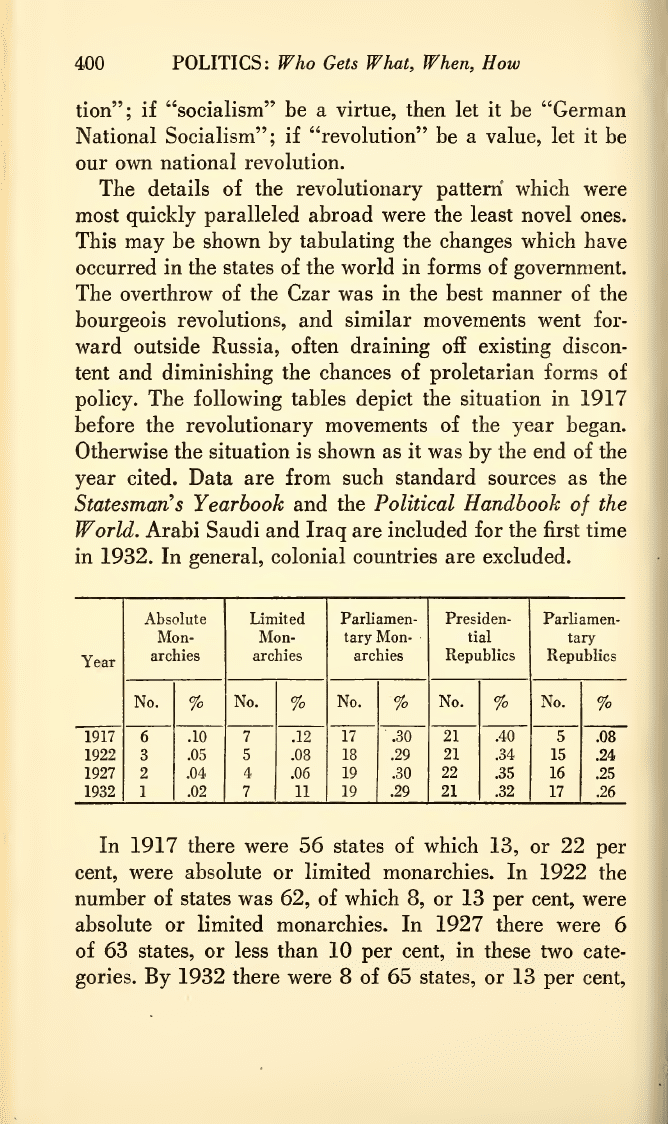
400
POLITICS:
Who Gets What, When, How
tion"; if
"socialism" be a
virtue,
then let it be "German
National
Socialism"; if
"revolution"
be
a value, let it
be
our own
national
revolution.
The details
of the
revolutionary pattern
which were
most
quickly
paralleled
abroad
were
the least novel ones.
This may
be shown by
tabulating the
changes
which
have
occurred in the states of the world
in forms
of
government.
The overthrow of
the Czar
was
in the
best
manner
of the
bourgeois revolutions, and
similar movements
went for-
ward outside Russia, often
draining off existing
discon-
tent and diminishing the chances of
proletarian forms
of
policy. The following tables depict the
situation
in 1917
before
the
revolutionary movements of
the year
began.
Otherwise
the
situation is shown as it was by the end of the
year cited. Data
are from such standard sources as the
Statesman*s Yearbook and
the Political
Handbook
of
the
World. Arabi
Saudi
and Iraq
are
included for the first time
in 1932. In general,
colonial countries are excluded.
Absolute Limited Parliamen- Presiden- Parliamen-
Mon- Mon-
tary Mon- tial
tary
Year
archies
archies archies Republics
Republics
No.
%
No.
%
No.
%
No.
%
No.
%
1917
6
.10 7 .12
17 .30 21 .40
5
.08
1922
3
.05 5 .08
18 .29 21 .34 15
.24
1927 2 .04
4
.06
19
.30
22
.35
16
.25
1932 1 .02 7
11 19 .29 21 .32
17 .26
In 1917 there were 56 states of which
13,
or 22
per
cent, were absolute or limited monarchies.
In 1922
the
number of states was
62,
of which
8,
or 13 per
cent, were
absolute
or limited
monarchies.
In 1927 there
were
6
of
63
states, or
less
than
10 per
cent, in
these two
cate-
gories.
By 1932 there were
8
of 65 states,
or 13 per cent.
